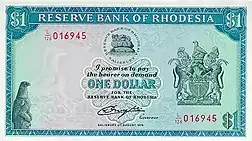Rhodesian dollar
The Rhodesian dollar (R$ or Rh$) was the currency of Rhodesia between 1970 and 1980. It was subdivided into 100 cents.
| Rhodesian dollar | |
|---|---|
 1 dollar note | |
| ISO 4217 | |
| Code | RHD |
| Denominations | |
| Subunit | |
| 1⁄100 | cent |
| Symbol | $ |
| Banknotes | 1, 2, 5, 10 dollars |
| Coins | 1⁄2, 1, 2 1⁄2, 5, 10, 20, 25 cents |
| Demographics | |
| User(s) | |
| Issuance | |
| Central bank | Reserve Bank of Rhodesia |
This infobox shows the latest status before this currency was rendered obsolete. | |
History
The dollar was introduced on 17 February 1970, less than a month before the declaration of a republic on 2 March 1970. It replaced the Rhodesian pound at a rate of 2 dollars to 1 pound. The dollar proved to be a strong currency, at parity with the pound sterling right up to the very end of Rhodesia in 1980, when it was replaced by the Zimbabwean dollar at par. However, the Rhodesian dollar was never a fully convertible currency and its exchange rate was therefore not an indication of the underlying economics.
Half pound
In adopting the Rhodesian dollar, Rhodesia followed the pattern of South Africa, Australia, and New Zealand in that when it adopted the decimal system, it decided to use the half pound unit as opposed to the pound unit of account. The choice of the name dollar was favoured by the then Minister of Finance, John Wrathall, who regarded it as having international substance.[1]
Coins
On 17 February 1970 the Rhodesian dollar was introduced and was par to the Pound; the currency was manufactured as follows - bronze 1⁄2 and 1 cent and cupro-nickel 2 1⁄2 cent coins were introduced, which circulated alongside the earlier coins of the Rhodesian pound for 5, 10, 20 and 25 cents, which were also denominated in shillings and pence. New 5-cent coins were introduced in 1973, followed by 10, 20 and 25 cents in 1975. Coins were struck until 1977 at the South African Mint in Pretoria.
Rhodesia had both 1/2 Cent and 2-1/2 Cents coins, just like in South Africa.
The 1/2 Cent coin was struck between 1970 and 1977 - with the 1977 1/2 Cent being extremely rare, with 10 coins known.
The 2-1/2 Cents (Tickey) was struck in 1970 only.
The 5 Cents was struck in 1973 and between 1975 and 1977.
The 10 and 25 Cents was struck in 1975 only.
The 20 Cents was struck in 1975 and 1977.
Tommy Sasseen was the designer of all Rhodesian coins from 1964 to 1968 (reverse only) and 1970 to 1977 (both obverse and reverse).
Banknotes
On 17 February 1970, the Reserve Bank of Rhodesia introduced notes in denominations of 1, 2 and 10 dollars.[2] 5-dollar notes were added in 1972.
| Image | Value | Dimensions | Main Colour | |
|---|---|---|---|---|
| Obverse | Reverse | |||
 |  | 1 dollar | Unknown | Blue |
 |  | 2 dollars | Unknown | Red |
 |  | 5 dollars | Unknown | Orange (brown background) |
 |  | 10 dollars | Unknown | Grey |
Exchange rate history
This table shows the historical value of one Rhodesian dollar.
| Date | Official Rate | Free / Parallel Rate | notes |
|---|---|---|---|
| 1970 (Feb) | USD 1.40 | - | Parallel market starts 1970 (July) |
| 1971 (Aug) | ZAR 1.00 | (- 30%) ZAR 0.769 | Pegged to the ZA Rand |
| 1971 (Dec) | USD 1.52 | (- 30% to 40%) USD 1.09 to US$1.17 | US dollar devalued |
| 1972 (July) | floated | (- 20% to 30%) | Floated at same time GBP was floated |
| 1972 (Oct) | USD 1.52; ZAR 1.19 | - | - |
| 1973 (Feb) | USD 1.69 | - | USD devalued |
| 1973 (Jun) | USD 1.773; ZAR 1.19 | - | ZA Rand and R$ revalued against USD |
| 1975 (Sep) | USD 1.60; ZAR 1.34 | - | R$ devalued against USD and ZAR |
| 1977 (Oct) | USD 1.50; ZAR 1.30 | (- 69%) USD 0.46; ZAR 0.40 | R$ devalued against USD and ZAR |
| 1980 (Mar) | - | - | Pegged to flexible basket (FRF, DEM, ZAR, CHF, GBP, USD) |
| 1980 (Apr) | - | - | Replacement by the Zimbabwean dollar Z$1 = R$1 |
| 1981 | - | - | Rhodesian dollar demonetised under Statutory Instrument 378 of the Government of Zimbabwe |
References
- Unpopular Sovereignty: Rhodesian Independence and African Decolonization, Luise White, University of Chicago Press, 2015, page 124
- Linzmayer, Owen (2012). "Rhodesia". The Banknote Book. San Francisco, CA: BanknoteNews.com.
- Krause, Chester L.; Clifford Mishler (1991). Standard Catalog of World Coins: 1801–1991 (18th ed.). Krause Publications. ISBN 0873411501.
- Pick, Albert (1994). Standard Catalog of World Paper Money: General Issues. Colin R. Bruce II and Neil Shafer (editors) (7th ed.). Krause Publications. ISBN 0-87341-207-9.
External links
- Rhodesian Currency Page, with a short description of each note.
| Preceded by: Rhodesian pound Reason: decimalization Ratio: 2 dollars = 1 pound |
Currency of Rhodesia (Zimbabwe since 1980) 1970 – 1980 |
Succeeded by: Zimbabwean dollar Reason: independence recognized Ratio: at par |